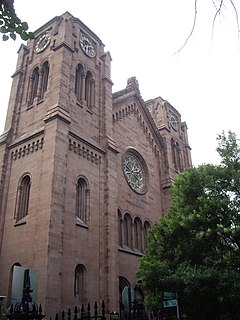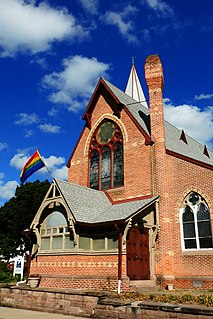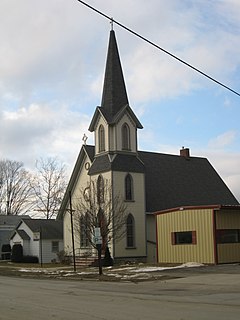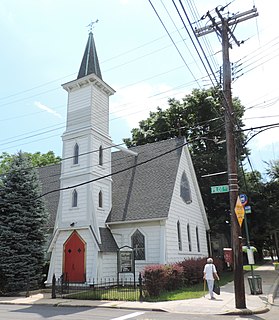
The Calvary Episcopal Church is located at 3766 Clifton Avenue, in the Clifton. It is part of the Clifton Avenue Historic District. Its Sunday School is a historic building listed in the National Register on March 3, 1980.
Calvary Episcopal Church may refer to:

St. George's Episcopal Church is a historic church located at 209 East 16th Street at Rutherford Place, on Stuyvesant Square in Manhattan, New York City. Called "one of the first and most significant examples of Early Romanesque Revival church architecture in America", the church exterior was designed by Charles Otto Blesch and the interior by Leopold Eidlitz. It is one of the two sanctuaries of the Calvary-St. George's Parish.
Henry C. Dudley (1813–1894), known also as Henry Dudley, was an English-born North American architect, known for his Gothic Revival churches. He was a founding member of the American Institute of Architects and designed a large number of churches, among them Saint Paul's Episcopal Cathedral in Syracuse, New York, built in 1884, and Trinity Church, completed in 1858.

The historic Christ Church Cathedral in Louisville, Kentucky was founded on May 31, 1822. The original church building was completed in 1824, a new Romanesque Revival facade was added in 1870. The structure was listed on the National Register of Historic Places in 1973.

The historic Calvary Episcopal Church was established in 1857 and is located at 821 South 4th Street Louisville, Kentucky. This stone gothic church was built in Old Louisville in 1888 and is listed on the National Register of Historic Places. The church is a member parish of the Episcopal Diocese of Kentucky.

Grace Episcopal Church, built in 1867, is an historic Episcopal church located at 1041 Wisconsin Avenue, NW, in the Georgetown neighborhood of Washington, D.C.. Historically known as Grace Protestant Episcopal Church, it was added under that name to the National Register of Historic Places on May 6, 1971. It is also known as Mission Church for Canal Boatmen.

Grace Episcopal Church is an historic Episcopal parish in Syracuse, New York. The Gothic Revival building was designed by Horatio Nelson White and was built in 1876. It is located at 819 Madison Avenue near Syracuse University. On March 20, 1973, it was listed on the National Register of Historic Places.

Edward Brickell White, also known as E. B. White, was an architect in the United States. He was known for his Gothic Revival architecture and his use of Roman and Greek designs.

The former Old Stone Church, also known as Calvary Episcopal Chapel, is an historic stone Late Gothic Revival-style Episcopal church building located at 206 North Wilcox Avenue in Buffalo, North Dakota, Built in 1885, it was designed by British architect George Hancock and built by Angus Beaton. Calvary Episcopal Chapel held its first services on October 15, 1886. In 1934, after years of many closings and reopenings, Calvary closed for the final time. In 1936, the building was bought by Buffalo Lodge No. 77 of the Ancient, Free & Accepted Masons. In the 1970s Buffalo No. 77 closed and in 1982 was merged with Casselton Lodge No. 3. In 1985, the Masons donated it to the Buffalo Historical Society, which 10 years later restored it. It is now called the Old Stone Church Heritage Center. On October 22, 1995, the Buffalo Historical Society received national recognition for its efforts from the National Trust for Historic Preservation. On March 29, 1996, the Old Stone Church was added to the National Register of Historic Places.

Calvary Episcopal Church, located at 102 North Second Street at Adams Avenue, in Memphis, Tennessee, in the United States, is an historic Episcopal church, founded August 6, 1832 by the Rev. Thomas Wright. The nave is the oldest public building in continuous use in the city of Memphis and was designed by Calvary's second Rector, The Rev. Philip Alston. There were several later additions: a tower in 1848, the chancel in 1881, the Parish Hall in 1903, and the Education Building in 1992. As Calvary Episcopal Church and Parish House, it was listed on the National Register of Historic Places in 1982.

The Oak Hill Cemetery Chapel, also known as the Renwick Chapel or James Renwick Chapel, is a historic building in the Georgetown neighborhood of Washington, D.C., United States. Designed by James Renwick, Jr. in 1850, Oak Hill Cemetery Chapel is the architect's only known example of Gothic Revival church architecture in Washington, D.C. It is located on the highest ridge in Oak Hill Cemetery, near the intersection of 29th and R Streets NW. The chapel is one of two structures in Oak Hill Cemetery listed on the National Register of Historic Places, the other being the Van Ness Mausoleum. The chapel, mausoleum, and cemetery are contributing properties to the Georgetown Historic District, a National Historic Landmark.

There are 71 properties listed on the National Register of Historic Places in Albany, New York, United States. Six are additionally designated as National Historic Landmarks (NHLs), the most of any city in the state after New York City. Another 14 are historic districts, for which 20 of the listings are also contributing properties. Two properties, both buildings, that had been listed in the past but have since been demolished have been delisted; one building that is also no longer extant remains listed.

Saint Andrew's Episcopal Church, also known as Calvary-Saint Andrew's Presbyterian Church, is a historic Episcopal church complex located at Rochester in Monroe County, New York. Designed by Richard M. Upjohn, it was constructed in phases between 1873 and 1880. The Gothic Revival style brick and stone complex consists of two interconnected sections: the church, composed of the church, bell tower, and entry porch, and the original rectory and chapel. The high altar and window were designed by George Hausshalter. The window was made by the Tiffany studios of New York. In 1968, the Saint Andrew's Episcopal Church merged with Calvary Presbyterian Church to form Calvary St. Andrews, a Presbyterian parish.

Grace Episcopal Church is a historic Episcopal church located at Whitney Point in Broome County, New York. It is a small wood framed church constructed in 1871 in the High Victorian Gothic style. It features a three-stage entrance tower surmounted by a spire and small wooden cross.

Grace Episcopal Church is a historic Episcopal church located at Waverly in Tioga County, New York. It is a Gothic Revival style wood frame structure, three bays wide and six bays deep, and resting on a brick foundation with cement veneer. The building was built in 1854 and features a steeply pitched gable roof, an arched double door entry, and lancet windows. A wooden belfry is perched on the peak of the gable.

Grace Episcopal Church is a historic Episcopal church at 116 City Island Avenue in The Bronx, New York, New York. The church was built in 1862 in the Carpenter Gothic style, and the rectory was built around that year in the Italian Villa style.

Calvary Episcopal Church is a historic Episcopal church on North Street west of Moon Hill Road in McDonough, Chenango County, New York. It was built about 1884 and is a small, one story frame chapel in the Carpenter Gothic style. It is approximately 28 feet wide and 64 feet deep and features board and batten siding and a steep gable roof with bell tower.

Calvary Church is an Episcopal church located at 277 Park Avenue South on the corner of East 21st Street in the Gramercy Park neighborhood of Manhattan, New York City, on the border of the Flatiron District. It was designed by James Renwick Jr., the architect who designed St. Patrick's Cathedral and Grace Church, and was completed in 1848. The church complex is located within the Gramercy Park Historic District and Extension. It is one of the two sanctuaries of the Calvary-St. George's Parish.

The Grace Church in Clarkesville, Georgia, also known as Grace-Calvary Episcopal Church, was built in 1839. It was listed on the National Register of Historic Places in 1980.





















